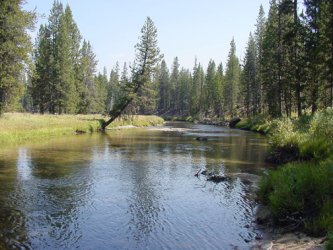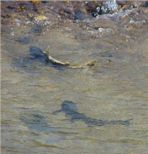04/13/01
Story and Photos by Evin Oneale
Fish and Game Regional Conservation Educator
The big fish are back in Bear Valley and they have to be tired.
Swimming virtually non-stop for one to three years in the Pacific
Ocean, Idaho's chinook salmon were suddenly and mysteriously
overcome with a desire to return home. So on they came, swimming
across the Pacific, to the mouth of the Columbia River. Guided by
their sense of smell, they moved upstream to the Snake River, then
up the Snake to Idaho's Salmon River. Still following their noses,
they pressed on, swimming up the Middle Fork of the Salmon River.
Passing dozens of small feeder streams, they arrived at Bear
Valley Creek. It has been months since they started the journey
and they have lost a third their body weight, but they are finally
home.
Fish and Game Fisheries Manager Dale Allen and his crew of fish
biologists are here too, walking the banks of Bear Valley, Elk and
Sulphur Creeks, counting the salmon egg nests or "redds"
constructed by the adult salmon. Each redd is relatively easy to
locate. Gravel, disturbed by the adult fish, glistens brightly in
the morning sunlight, contrasted by darker, undisturbed gravel
surrounding the redd. "We've been surveying these same
sections of stream and conducting redd counts for more than 30
years," Allen explained. "That accumulated data shows us
how well our chinook salmon are returning over time."
Home,
Sweet, Home . . . For eons, chinook salmon have returned to
Bear Valley Creek in central Idaho to spawn and complete their
lifecycle.
 |
The Bear Valley area has a key role to play in the recovery of
Idaho's chinook salmon. "Bear Valley is one of our wild
production areas for spring and summer chinook," Allen noted.
"Fish have never been removed for rearing in hatcheries, and
no hatchery fish have ever been introduced to this area. These
wild salmon genetics are critically important for recovery of
these summer chinook to Idaho.
While
his mate constructs a redd just upriver, a big male chinook
salmon keeps another, smaller male at bay. Male chinook will
aggressively protect their chosen mates from rogue males.
 |
A big female chinook has chosen a site to lay her eggs in Bear
Valley Creek. Perhaps she is content simply to be laying those
eggs somewhere in her natal stream. Or perhaps, she has searched
carefully and located the exact spot where, four or five years
earlier, she began life as a tiny egg in this high basin stream.
Regardless, the redd-building procedure is a sight to behold. The
big fish rolls on her side, thrashing her tail vigorously to
disturb the streambed gravels, forming a shallow depression. This
process may continue for hours until the redd is fashioned to the
female's liking.
As redd construction continues, and with her mate standing by,
the female settles into the redd, laying a series of eggs that
filter into the gravel bottom. The male chinook moves just
upstream, releasing a cloud of sperm that drifts down onto the
eggs. The female then uses her tail to enlarge the redd upstream
from the now fertilized eggs, burying this next generation of
salmon in the process. The entire performance is repeated until
the female has expelled all 4,500 to 5,000 eggs. Exhausted from
the effort, both adults rest. The female may remain an attentive
guardians at the nest for as long as her energy lasts. The male
may seek out other mates. Producing the next generation of salmon
will be their last act.
Like all members of the salmon family (except steelhead),
chinook adults die following spawning. It's a marvelously simple
and wonderful system that our techno-crazed society cannot
duplicate. After one to three years of non-stop feeding in the
ocean, storing nutrients found no where else on earth, Idaho's
chinook salmon return home. After death, their bodies break down,
releasing those unique nutrients into high elevation Idaho
streams, most of which are otherwise nearly hospital-sterile. The
nutrients revitalize the stream system, and are the building
blocks for the food chain that will ultimately sustain the
chinook's offspring during their first year of life. So, even in
death, adult chinook provide for their progeny. Up to 137 diff
species have been known to use salmon carcasses and they also
contribute nutrients to the ecosystem as they decay.
In a three-day period, Allen and his crew survey 50 miles of
stream, counting 177 salmon redds, 103 of those in Elk Creek
alone. That's up considerably from the years from which these
salmon were spawned. In 1995, a total of ten redds were counted
and in 1996, 45 redds were counted. All the fish returning this
year are progeny from that collection of 55 redds.
This year's run has more than replaced itself, but the numbers
in no way represent recovery. Rather, they are a shot in the arm
for a species struggling at the brink of extinction. "The
number of adult salmon returning to the Bear Valley area is about
one fourth the number we documented returning here during the
1950s and 1960s," Allen noted.
In the 1960s (the "good old days" in the memory of
Idaho salmon anglers), thousands of big chinook salmon returned to
the Bear Valley region of Idaho. And the anglers followed.
"In the 1960s we had salmon fishing seasons up here in Bear
Valley and Elk Creeks that were wildly popular," Allen said.
What a difference a few years make. Idaho's last wild salmon
season was held in 1978. In the Bear Valley area, fishing ended
many years earlier. "Now, instead of salmon fishing here in
Bear Valley, we're dealing with an endangered species," Allen
said grimly.
Allen is grateful for this year's boost in salmon numbers,
however slight. "Numbers are better this year than we had
predicted," Allen said. "These fish went out to the
ocean in 1997 or 1998 and have returned in numbers that are higher
than the number of redds we counted when these fish were just
salmon eggs, that is, 1995 or 1996." Good outgoing flows when
smolts are migrating to the ocean improve the chances of getting a
good upstream migration when those fish mature.
As fall gives way to winter, the tiny salmon eggs, so carefully
deposited by adult salmon now long gone, will slowly develop, safe
and protected in the stream bottom. Emerging from the gravel next
spring, the tiny salmon fry will start the salmon life cycle anew,
doing their part to stave off extinction and perhaps, serve as the
backbone for salmon recovery and a return to the "good old
days."